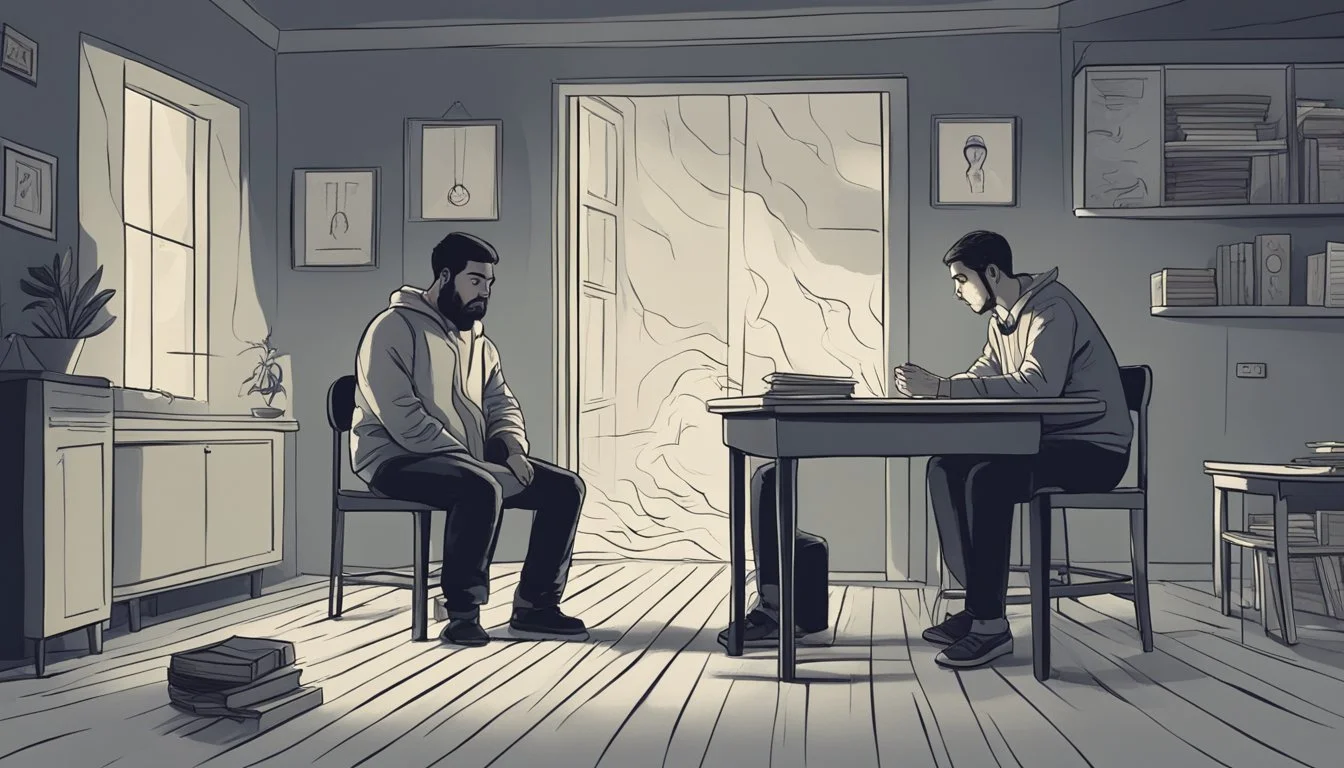5 Differences Between PTSD and Schizophrenia
Key Distinctive Traits Explained
Understanding the differences between PTSD and schizophrenia is crucial for both sufferers and healthcare professionals. These two conditions, while sometimes presenting overlapping symptoms, stem from different causes and require distinct approaches in treatment and management.
Grasping these differences can lead to better diagnosis and a clearer path to effective care. By exploring these key distinctions, one can gain valuable insights into how each disorder uniquely affects mental health. This article aims to elucidate five core differences to enhance awareness and aid in proper diagnosis and treatment plans.
1) Diagnostic Criteria Differences
Schizophrenia and PTSD have distinct diagnostic criteria outlined in the DSM-5.
Schizophrenia is diagnosed based on the presence of symptoms like delusions, hallucinations, disorganized speech, and negative symptoms for at least six months. These symptoms must cause significant impairment in social, occupational, or personal functioning.
In contrast, PTSD is diagnosed based on exposure to a traumatic event. Symptoms include intrusive thoughts, avoidance behaviors, negative changes in mood and cognition, and increased arousal. These symptoms need to last for more than one month and cause significant distress or impairment.
The DSM-5 updated criteria for schizophrenia to provide more reliable diagnoses. It no longer separates delusional disorder from shared delusional disorder if criteria for delusional disorder are met.
Up to 70% of returning veterans experience PTSD, often overlapping with the age range for the onset of schizophrenia. Both disorders require specific criteria to differentiate schizophrenia from PTSD, emphasizing different symptomatology and triggers.
Significant distinctions in diagnostic criteria help clinicians provide accurate diagnoses, enabling effective treatment for each disorder based on individual symptoms and history.
2) Symptom Presentation Variations
Individuals with PTSD and schizophrenia exhibit distinctive symptom variations.
PTSD often results in re-experiencing the traumatic event through flashbacks, nightmares, and intrusive thoughts. In contrast, schizophrenia predominantly features symptoms like hallucinations and delusions.
Patients with PTSD may display hyperarousal, characterized by heightened alertness, irritability, and difficulty sleeping. Schizophrenia, on the other hand, manifests negative symptoms such as social withdrawal, lack of motivation, and flat affect.
Anxiety and fear are common in PTSD, triggered by reminders of trauma. Schizophrenia patients experience cognitive symptoms, including disorganized thinking and impaired memory.
Both disorders may present psychotic symptoms, confusing diagnosis. Research shows that psychotic symptoms typical of schizophrenia occur frequently in PTSD. This overlap complicates distinguishing between PTSD and schizophrenia.
The presence of negative symptoms, like reduced emotional expression, is associated more with schizophrenia. PTSD might involve emotional numbness but is less pronounced compared to schizophrenia’s negative symptoms.
Understanding these distinctions can aid clinicians in accurately diagnosing and treating each condition. For more detailed insights, visit related research.
3) Treatment Approaches
The treatment for PTSD often involves a combination of psychotherapy and medication. Cognitive Behavioral Therapy (CBT) is commonly used to help patients address and manage their traumatic memories and symptoms.
On the other hand, schizophrenia treatment typically centers around antipsychotic medications. These medications help control symptoms such as hallucinations and delusions. Psychotherapy can also be beneficial for patients with schizophrenia to support medication adherence and social skills.
Patients with co-occurring PTSD and schizophrenia may require a tailored approach. This includes simultaneous treatment for both conditions. Integrated care models aim to address the unique challenges faced by these patients.
Trauma-focused therapies, like Eye Movement Desensitization and Reprocessing (EMDR), can be effective in treating PTSD symptoms in patients with schizophrenia. These therapies need to be carefully managed to prevent exacerbation of psychotic symptoms.
In some cases, treating schizophrenia with antipsychotics can reduce the PTSD-related symptoms as well. Both conditions require ongoing monitoring and adjustments to treatment plans to ensure optimal outcomes.
Professionals need to consider the individual patient's background and symptomatology when formulating a treatment plan. This careful balancing can improve the quality of life for individuals managing both PTSD and schizophrenia.
Information on treatment strategies can be further explored by referring to PTSD with psychosis or schizophrenia-spectrum disorders.
4) Impact on Daily Functioning
Both PTSD and schizophrenia have profound effects on daily functioning. However, they manifest differently in individuals.
People with schizophrenia often experience cognitive impairments that can interfere with tasks like managing finances, completing work, and maintaining personal hygiene. Social interactions may become challenging due to symptoms like hallucinations or delusions.
PTSD primarily affects emotional and psychological functioning. Individuals might find it difficult to engage in social situations or perform at work due to recurrent flashbacks or heightened anxiety. These symptoms can hinder their ability to focus and maintain relationships.
In cases where both disorders coexist, the impact can be compounded. The combination of cognitive deficits from schizophrenia and emotional disturbances from PTSD can make independent living extremely difficult.
Support from mental health professionals and tailored treatment plans can significantly improve daily functioning for individuals dealing with these disorders. This may include therapy, medications, and support groups to help manage symptoms and improve quality of life.
5) Onset and Progression
Posttraumatic Stress Disorder (PTSD) typically arises after an individual experiences a traumatic event such as a physical assault, natural disaster, or military combat. Symptoms can manifest within days to months after the incident. They may include flashbacks, nightmares, and severe anxiety. PTSD often progresses with fluctuations in severity, depending on the individual's exposure to triggers.
Schizophrenia, on the other hand, generally emerges during late adolescence to early adulthood. The condition's onset is usually gradual, marked by subtle changes in behavior, cognition, and emotional response. During the prodromal phase, individuals might exhibit social withdrawal or suspicious thinking. Full-blown psychotic episodes often follow, typified by hallucinations, delusions, and disorganized thinking.
The progression of schizophrenia is typically chronic, requiring long-term management. The course can vary, with some people experiencing episodic flare-ups and others showing a more continuous pattern of symptoms. This condition's intricate nature often involves both genetic predispositions and environmental factors influencing its development.
In contrast, PTSD progression can be influenced by treatment, coping strategies, and support systems. Effective interventions may significantly reduce symptoms and improve quality of life. Meanwhile, delays in addressing PTSD can lead to the condition becoming more entrenched and affecting various aspects of one's life.
The differences in onset and progression highlight the unique challenges posed by each disorder. Understanding these can guide more tailored and effective approaches to treatment and support for individuals affected by PTSD or schizophrenia.
Core Symptoms and Characteristics
Post-Traumatic Stress Disorder (PTSD) and Schizophrenia are distinct conditions each characterized by unique symptoms. PTSD is often associated with traumatic events, while Schizophrenia involves chronic mental disturbances.
Hallucinations vs. Flashbacks
Hallucinations are a hallmark of Schizophrenia. Individuals may see, hear, feel, smell, or taste things that are not present. These false perceptions can significantly disrupt daily life and are resistant to reasoning. Hallucinations can be auditory (hearing voices), visual (seeing things), tactile (feeling sensations), and more.
Flashbacks are prominent in PTSD and involve re-experiencing traumatic events. These vivid, intrusive memories are often triggered by reminders of the trauma. Unlike hallucinations, flashbacks are based on real past events and can cause intense emotional and physical reactions. They may feel like reliving the trauma, leading to distress and disruption.
Delusions vs. Hypervigilance
Delusions are a key feature of Schizophrenia. These are false beliefs firmly held despite contradictory evidence. Common delusions include paranoia, believing one has special powers, or that they are being persecuted. Delusions can be bizarre or non-bizarre and significantly impact a person's ability to function normally.
Hypervigilance is a symptom of PTSD and involves an enhanced state of sensory sensitivity. Individuals are excessively aware of their surroundings, quickly reacting to potential threats. This heightened alertness results from the constant expectation of danger and is often accompanied by irritability, difficulty concentrating, and sleep disturbances.
In summary, while Schizophrenia is marked by persistent hallucinations and delusions, PTSD involves recurrent flashbacks and a state of hypervigilance. Both sets of symptoms are disruptive but arise from different origins and perceptions.
Diagnostic Criteria
When comparing PTSD and schizophrenia, it's essential to understand the diagnostic criteria, which vary significantly between these two distinct mental health conditions.
DSM-5 Guidelines
Post-traumatic stress disorder (PTSD) is classified under Trauma- and Stressor-Related Disorders in the DSM-5. The diagnostic criteria for PTSD include exposure to a traumatic event, presence of intrusive symptoms (such as flashbacks or nightmares), avoidance behaviors, negative changes in thoughts and mood, and heightened arousal.
Schizophrenia, on the other hand, falls under Schizophrenia Spectrum and Other Psychotic Disorders. The criteria require at least two of the following symptoms: delusions, hallucinations, disorganized speech, grossly disorganized or catatonic behavior, and negative symptoms like diminished emotional expression.
PTSD requires symptoms to be related directly to a traumatic experience, whereas schizophrenia involves psychotic symptoms without the necessity of a trauma-related trigger or cause.
Duration and Onset of Symptoms
For PTSD, the DSM-5 mandates symptoms must persist for more than one month after the traumatic event. Symptoms can begin immediately or have a delayed onset, sometimes appearing several months or even years later.
Schizophrenia requires continuous signs of disturbance to be present for at least six months, with at least one month of active-phase symptoms (as listed under DSM-5 guidelines). The onset is typically during late adolescence to early adulthood and can develop gradually or suddenly.
The nuanced difference in symptom duration and onset is crucial for diagnosis, impacting how mental health professionals distinguish between these disorders.




